| کد مقاله | کد نشریه | سال انتشار | مقاله انگلیسی | نسخه تمام متن |
|---|---|---|---|---|
| 2085505 | 1545378 | 2010 | 10 صفحه PDF | دانلود رایگان |

PurposeThe block copolymers PEG2000-b-PLA2200, PEG2000-b-PCL2600 and PEG5000-b-PCL5000 have been currently identified as optimal solubilizing agents for Sagopilone, a poorly water-soluble anticancer drug. In the present study, the stability, formulation feasibility and in vitro as well as in vivo toxicity were evaluated.MethodsDispersion media, storage conditions, and dilutions were varied for stability assessment. The critical micelle concentration (CMC) was determined using a fluorescent probe technique. Lyophilizates and polymeric films were investigated as formulation options. Furthermore, the toxicity was studied in vitro and in vivo using HeLa/MaTu cells and a nude mouse model, respectively.ResultsA drug–polymer ratio as low as 1:20 (w/w) was sufficient to solubilize Sagopilone effectively and to obtain stable dispersions (24 h: drug content ⩾95%). Although the micelles exhibited a similar thermodynamic stability (CMC: 10−7–10−6 M), PEG-b-PCL micelles were kinetically more stable than PEG2000-b-PLA2200 (24 h at 37 °C: drug content ⩾90% compared to 30%, respectively). Lyophilization of PEG-b-PCL micelles and storage stability of solid drug-loaded PEG2000-b-PLA2200 films (3 m, 6 °C: drug content of (95.6 ± 1.4)%) were demonstrated for the first time. The high antiproliferative activity has been maintained in vitro (IC50<1 nM). Carrier-associated side effects have not been observed in vivo and the maximum tolerated dose of micellar Sagopilone was determined to be 6 mg/kg.ConclusionThe results of this study indicate that polymeric micelles, especially PEG-b-PCL micelles, offer excellent potential for further preclinical and clinical cancer studies using Sagopilone.
Journal: European Journal of Pharmaceutics and Biopharmaceutics - Volume 75, Issue 2, June 2010, Pages 80–89